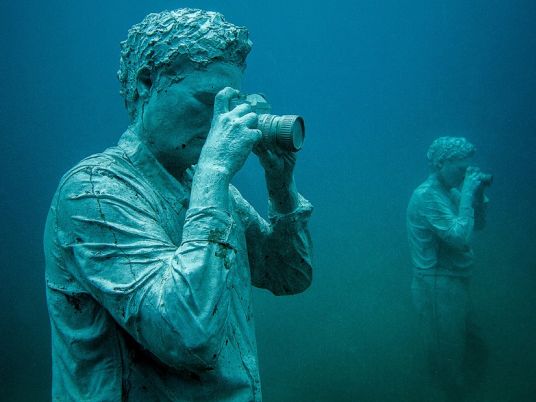
In the shallow waters off the coast of Cancun in Mexico lies an underwater field of figures. Colorful sponges cover their stony faces and layers of vibrant coral grow around their shape.
This is Museo Subacuático de Arte, the world's first underwater museum created by British sculptor Jason deCaires Taylor with the idea to make art and the marine environment interact. He covers his exhibits in cement that attracts coral growth, then submerges them to the ocean floor, letting tropical coral overtake their surface and eventually form a new reef.

Ring of children, Grenada
In one installation, statues that represent a ring of children have been placed in an area where two currents meet in order to symbolize human adaptability to new surroundings.
"Some of the currents provided nutrients to one side of the circle, and the other side didn't get the same amount of nutrition," says Taylor. "So it became about how these children evolved in their surrounding and how we're all united in the circle."

Planting corals
Taylor plants corals on his figures, but says he never disturbs natural settings, instead using those grown in nurseries or damaged by tourists.
"I'm always trying to communicate how incredible this underwater world is, but also how it's under deep threat at the moment with climate change," he says.

Un-still Life
The artist makes the sculptures as heavy as possible so they stay on the seabed once secured, and then transports them underwater in a process that can last up to six months. Works are made of pH-neutral cement, and over time sponges and corals encrust the surfaces in a myriad of colorful and unexpected patterns.

Holy man
"Sometimes I go back and I'm completely amazed at this formation that occurred on the face. It's like walking into something completely different," says Taylor.
"Occasionally, I'll be completely disappointed. There will be an algae that covered the face and made it go black," he adds.

Anthropocene
Apart from encouraging the growth of the area's marine life, Taylor is also keen to highlight the identity of the region that hosts his works.
"I don't want it to be just myself bringing my ideas to a place, I want it to represent local culture," he says.
That idea was behind his decision to submerge a VW Beetle in Mexico, a car that has an iconic status in the country, but which also presented an ideal refuge for marine life.
"The Beetle has the perfect shape for underwater. It's rounded, so crustacean like lobsters and crabs can live inside it without the danger of being caught by fishermen. I went back to see it about six months ago and it had almost 100 lobsters living in it," says Taylor.

Bankers
The artist doesn't shy away from a strong metaphor, such as the installation shown above, showing bankers with their heads buried in the sand.
"This was a piece referencing climate change and global warming, and how we tend to be living in denial at the moment, forgetting the future for short-term gain," says Taylor.
"The Caribbean has lost so much of its natural reef, I think it really is a critical situation."

Resurrection
The feeling of weightlessness underwater allows visitors to roam the museum with ease, examining the sculptures from every view point — floating above them or swimming away to observe them in the vast landscape.
"The light changes completely according to the weather," says Taylor. "Sometimes you get these huge shafts of light breaking through the water. Other times, it's more subdued and almost mist-like."

The lost correspondent
"Because you're placed in an alternative world, your imagination is almost a little bit more open. It's a bit like being in a dream where you're a bit more suggestible to new ideas," he says.

Silent evolution
His next project has taken him to the slightly cooler waters of the Atlantic Ocean, off the coast of Canary Islands, where he is currently creating a new underwater botanical garden. The conditions there are clear, but lack the intense tropical corals of the Caribbean.
"Here it's a little bit more subdued, but there's an abundance of fish and sea urchins which actually clean the sculpture's surfaces at night. So whereas in the past things would be obscured very quickly, I have to work out how I will be planting things in a different way," he says.

